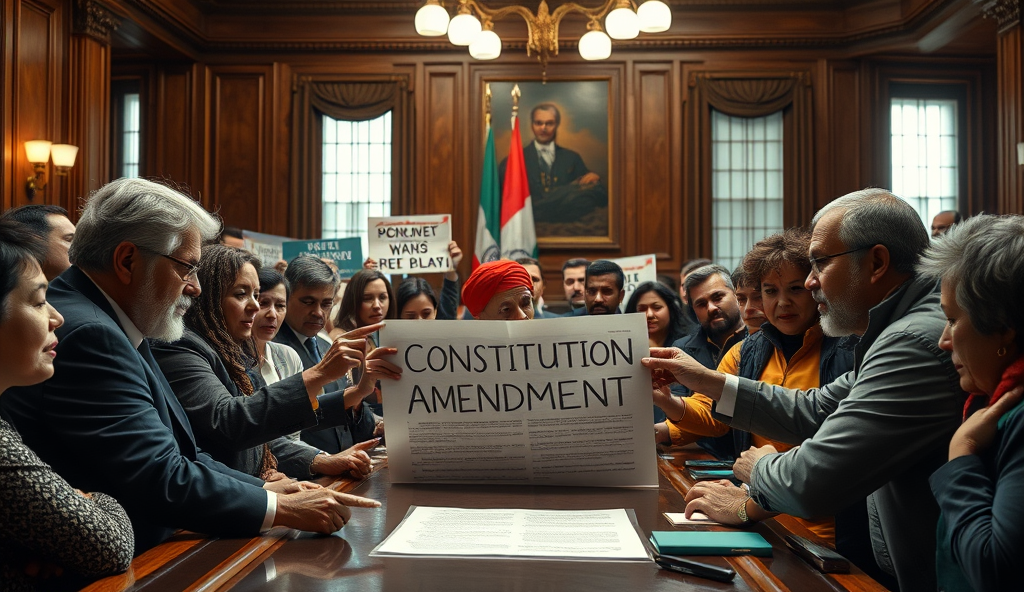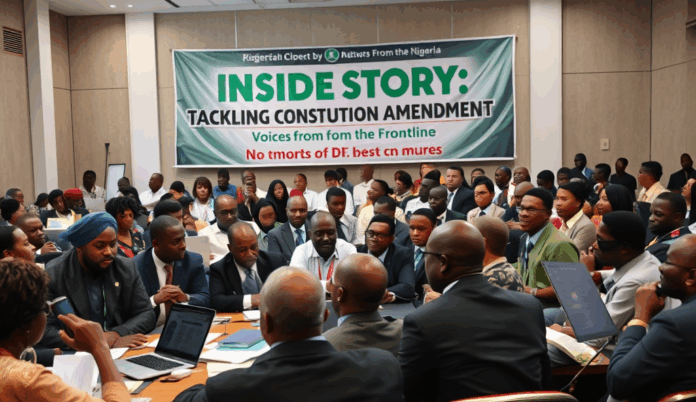Introduction to the Constitution Amendment Process in Nigeria
The process of amending the Nigerian Constitution is enshrined in Section 9 of the 1999 Constitution, requiring a rigorous two-thirds majority approval from both the National Assembly and State Houses of Assembly. This dual-layer legislative involvement ensures federal character representation while balancing national and regional interests in constitutional reforms.
Recent proposals for Constitution Amendment in Nigeria have highlighted key challenges, including divergent regional priorities and lengthy deliberation periods, as seen in the 2022 review process that spanned 18 months. The National Assembly role in Constitution Amendment remains pivotal, with the current 10th Assembly prioritizing devolution of powers and fiscal federalism as focal points.
Understanding this framework sets the stage for examining historical amendments, which reveal evolving patterns in Nigeria’s constitutional development. The next section will explore how past changes have shaped today’s amendment dynamics, offering critical insights for legal professionals navigating current reforms.
Key Statistics

Historical Context of Previous Amendments in Nigeria
The process of amending the Nigerian Constitution is enshrined in Section 9 of the 1999 Constitution requiring a rigorous two-thirds majority approval from both the National Assembly and State Houses of Assembly.
Nigeria’s constitutional evolution reflects shifting power dynamics, with the 1960 Independence Constitution undergoing five major amendments by 1963 to address regional autonomy concerns. The 1979 Constitution introduced presidentialism but was amended in 1985 to curb executive excesses, showcasing how political transitions shape amendment priorities.
The 1999 Constitution has seen four revisions, notably the 2010 amendment which extended judicial tenure and the 2018 review that strengthened local government autonomy. These changes demonstrate the National Assembly’s role in Constitution Amendment as a mediator between federal and state interests, though implementation gaps persist.
Historical amendments reveal recurring themes like fiscal federalism and devolution, directly informing the current 10th Assembly’s focus areas. This legacy of incremental reforms sets the stage for analyzing contemporary objectives in the ongoing constitutional review process.
Key Objectives of the Current Constitution Amendment Process
The 1999 Constitution has seen four revisions notably the 2010 amendment which extended judicial tenure and the 2018 review that strengthened local government autonomy.
Building on Nigeria’s legacy of constitutional reforms, the 10th National Assembly prioritizes resolving persistent fiscal federalism disputes, evidenced by ongoing debates over resource control and revenue allocation formulas. The process also seeks to enhance local governance by addressing implementation gaps in the 2018 local government autonomy provisions, which 15 states still resist despite constitutional backing.
Another key objective is restructuring Nigeria’s federation through proposed state police creation and revised legislative lists, responding to security challenges and regional demands for devolution. These align with historical amendment patterns while incorporating contemporary needs like gender equity provisions, reflecting evolving societal expectations since the 1999 Constitution’s inception.
The amendment process deliberately incorporates broader public participation through zonal hearings and digital platforms, learning from past criticisms of elite-driven changes. This approach sets the stage for evaluating specific proposals in the next section, where contentious issues like rotational presidency and judicial reforms take center stage.
Major Proposed Changes in the Ongoing Amendment
The ongoing Constitution Amendment process introduces transformative proposals including a revised revenue allocation formula that would increase states' share from 26.72% to 35%.
The ongoing Constitution Amendment process introduces transformative proposals, including a revised revenue allocation formula that would increase states’ share from 26.72% to 35%, addressing long-standing fiscal federalism disputes. These changes directly respond to resource control demands from oil-producing regions, building on the 10th National Assembly’s commitment to restructuring Nigeria’s federation.
Key security reforms feature prominently, with 23 state assemblies already endorsing the creation of state police forces through constitutional amendments. This aligns with regional security needs while revisiting legislative lists to clarify federal-state responsibilities, mirroring historical amendment patterns since 1999.
Gender equity provisions propose 35% affirmative action for women in governance, alongside constitutional recognition for local government autonomy still resisted by 15 states. These changes reflect evolving societal expectations while setting the stage for examining the National Assembly’s procedural role in advancing these amendments.
Role of the National Assembly in the Amendment Process
The National Assembly serves as the primary driver of constitutional amendments initiating proposals like the 35% revenue allocation increase and state police framework through its constitutional review committees.
The National Assembly serves as the primary driver of constitutional amendments, initiating proposals like the 35% revenue allocation increase and state police framework through its constitutional review committees. These committees consolidate inputs from state assemblies and stakeholders, following Section 9 of the 1999 Constitution which mandates a four-fifths majority vote in both chambers for amendments.
Recent amendments reveal strategic sequencing, with the 10th Assembly prioritizing fiscal federalism and security reforms before addressing gender equity and local government autonomy. This phased approach mirrors the 8th Assembly’s successful passage of 15 amendments while avoiding contentious issues that stalled previous attempts.
The Assembly’s procedural rules require harmonization between Senate and House versions before transmission to state legislatures, creating checks that ensure balanced reforms. This meticulous process sets the foundation for evaluating public participation in subsequent stages, particularly for amendments like state police that have gained 23 state endorsements.
Public Participation and Stakeholder Engagement in the Amendment
Given the procedural complexities highlighted earlier the National Assembly projects a 24-month timeline for completing the constitutional review process with final ratification expected by Q4 2025.
The National Assembly’s constitutional review committees have expanded public participation through zonal public hearings, with over 5,000 memoranda submitted during the 10th Assembly’s ongoing process. Civil society groups like the Nigerian Bar Association and SERAP have actively shaped proposals on fiscal federalism and state police, reflecting the 23 state endorsements mentioned earlier.
Stakeholder engagement has proven critical for contentious amendments, as seen in the 8th Assembly’s successful gender equity reforms that incorporated inputs from women’s rights organizations. However, regional disparities persist, with northern states showing lower participation rates compared to southern zones in recent hearings.
This uneven engagement foreshadows potential challenges in achieving consensus, particularly for reforms like local government autonomy that face resistance from state governors. The next section examines these controversies and institutional roadblocks in greater detail.
Challenges and Controversies Surrounding the Amendment
The constitutional review process faces entrenched opposition from state governors, particularly regarding local government autonomy, with 19 states currently resisting fiscal and administrative independence for LGAs. This aligns with the regional participation disparities noted earlier, as northern governors cite concerns over security and governance efficiency while southern states push for devolution of powers.
Judicial interpretations further complicate amendments, as seen in the 2022 Supreme Court ruling that nullified parts of the 8th Assembly’s amendments on technical grounds. Legal professionals note such precedents create uncertainty around the enforceability of proposed changes, especially for contentious issues like state police creation.
These controversies highlight the delicate balance required in Nigeria’s constitutional review process, where political will often clashes with legal technicalities. The next section explores how these dynamics directly impact legal practitioners navigating the evolving constitutional landscape.
Implications of the Amendment for Legal Professionals in Nigeria
The ongoing constitutional review process demands heightened vigilance from legal practitioners, particularly given the Supreme Court’s 2022 precedent of nullifying amendments on technicalities. Lawyers must now scrutinize draft provisions for compliance with procedural requirements while advising clients on potential enforceability risks, especially concerning state police or local government autonomy.
Regional disparities in amendment priorities create divergent legal landscapes, requiring practitioners to master both federal and state-specific constitutional interpretations. For instance, northern lawyers face distinct security-related legislative challenges compared to southern counterparts advocating for devolution of powers under Nigeria’s federalism framework.
These complexities underscore the need for continuous professional development, as the National Assembly’s final amendments will trigger cascading changes across contract law, governance advisory services, and judicial review processes. The subsequent section examines projected timelines for completing this multifaceted amendment process amid these legal uncertainties.
Timeline and Expected Completion of the Amendment Process
Given the procedural complexities highlighted earlier, the National Assembly projects a 24-month timeline for completing the constitutional review process, with final ratification expected by Q4 2025 based on current legislative calendars. This extended duration accounts for mandatory state-level consultations and potential judicial reviews, particularly for contentious clauses like state police creation or fiscal federalism adjustments.
Historical data shows Nigeria’s previous amendment cycles averaged 18-30 months, with the 2010-2011 review taking 22 months despite fewer contentious issues. Current delays stem from divergent regional priorities, requiring additional reconciliation sessions between federal and state legislatures to align amendment proposals.
Legal practitioners should anticipate staggered implementation, as ratified amendments may face immediate court challenges under Section 9 of the Constitution, mirroring the Supreme Court’s 2022 nullification precedent. The next section details proactive strategies for staying informed as these timelines evolve.
How Legal Professionals Can Stay Updated on the Amendment
Given the protracted constitutional review process and potential judicial interventions, legal practitioners should subscribe to the National Assembly’s official gazettes and committee reports, which provide real-time updates on amendment progress. The Nigerian Law Reform Commission’s quarterly bulletins also offer analyzed insights into proposed changes, similar to their 2021 publication on fiscal federalism debates.
Regional bar associations like the Nigerian Bar Association (NBA) frequently host webinars with National Assembly members, as seen during the 2022 state police deliberations. Setting Google Alerts for keywords like “Constitution Amendment Nigeria” or following verified legislative Twitter accounts (@nassnigeria) ensures timely updates amidst evolving timelines.
For deeper analysis, practitioners can access the Supreme Court’s online repository for pending constitutional cases, mirroring the approach used during the 2022 nullification precedent. These multilayered tracking methods prepare lawyers for the staggered implementation phase discussed in subsequent sections.
Conclusion on the Constitution Amendment in Nigeria
The ongoing Constitution Amendment process in Nigeria reflects both the complexities of federalism and the persistent demands for restructuring, as seen in recent proposals for devolution of powers. With the National Assembly and State Houses of Assembly playing pivotal roles, the current review process highlights the need for broader public participation to address key challenges like resource control and fiscal federalism.
Historical amendments to Nigeria’s Constitution, such as the 2010 reforms, demonstrate how judicial interpretation and political will shape outcomes, yet unresolved issues like state policing remain contentious. Recent debates underscore the delicate balance between regional interests and national cohesion, particularly in proposals for rotational presidency and local government autonomy.
As stakeholders await further developments, the success of this amendment cycle will depend on transparent deliberations and consensus-building among federal and state actors. The next phase must prioritize inclusivity to ensure the final document addresses Nigeria’s evolving governance needs while maintaining constitutional legitimacy.
Frequently Asked Questions
What are the key procedural requirements for passing a Constitution Amendment in Nigeria?
Section 9 of the 1999 Constitution mandates a two-thirds majority in both National Assembly chambers and approval by 24 state assemblies. Practical tip: Track voting thresholds using the National Assembly's official vote tally dashboard.
How can legal professionals monitor ongoing Constitution Amendment proposals in real-time?
Subscribe to the Nigerian Law Reform Commission's email alerts and follow @nassnigeria on Twitter for live updates. Practical tool: Set up Google Alerts for 'Nigeria Constitution Amendment 10th Assembly'.
What historical precedents should lawyers consider when analyzing current Constitution Amendment proposals?
Review the Supreme Court's 2022 nullification of amendments and the 2018 local government autonomy case. Practical tip: Access case law through the Nigerian Judiciary's online repository (NJRS).
How does the current Constitution Amendment process address fiscal federalism concerns?
Proposals include increasing states' revenue share to 35% and clarifying resource control mechanisms. Practical tool: Use the Revenue Mobilization Allocation and Fiscal Commission's calculator to model impacts.
What strategies can lawyers employ to challenge unconstitutional amendments after passage?
File suit under Section 6(6)(b) of the 1999 Constitution citing procedural flaws or federalism violations. Practical tip: Consult the NBA's constitutional litigation toolkit for precedent-based arguments.


